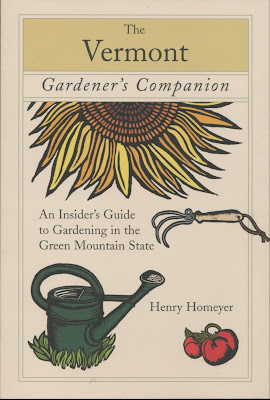I'm excited that Lisa Sausville of Vermont Coverts is coming to the Davies Memorial Library on September 27, to talk about managing our lands (whether back yard or acres) to be better habitat for wildlife (watch for the event announcement). At my house, a couple of years ago I put up five birdhouses ... and then realized that they wouldn't get new occupants if they didn't have enough trees and bushes around them to make the birds feel safe. So of course, I planted more.
And this was around the same time that I was encouraging mint to grow in various areas of the yard, to try to send the deer away from my flowers and vegetables. It's all about planning, I guess!
But I really want to hear this professional speaking about how to look at the yard in terms of wildlife. Also, in terms of getting ready for her visit, I took a look at the recommended resources on the Vermont Coverts website (http://www.vtcoverts.org) -- and there are lots! Here is the book list. I was happy to find that I have a couple of these, and I'll be looking for the others. If you have some you'd like to share at the library, this would be a great time to donate them for a special collection!
Suggested Reading List
Forestry:
 | |
| House wrens nested in this one ... |
- Working With Your Woodland - Beattie, Levine and Thompson. University Press of New England.
- A Guide To Logging Aesthetics - Jones. Northeast Regional Agricultural Engineering Service. Publication #NRAES-60
- Reading The Forested Landscape - Wessels. Countryman Press.
- The Nature of Vermont - Johnson. University Press of New England.
- The Northern Forest - Dobbs and Ober.
- The Woodland Steward - Fazio. The Woodland Press.
- The Tree Identification Book - Symonds.
- A Landowner's Guide to Building Forest Access Roads - Weist. USDA Forest Service Publication #NA-TP-06-98.
- Owning and Managing Forests - McEvoy. Island Press.
- Positive Impact Forestry - McEvoy. Island Press.
- A Sand Country Almanac - Leopold. Ballantine Press.
- Wetland. Woodland. Wildland - A Guide to the Natural Communities of Vermont - Thompson and Sorenson. University Press of New England.
- Wildlife Habitat Management for Vermont Woodlands-A Landowner's Guide. VT Fish and Wildlife Dept., Waterbury, VT.
- Management Guide for Deer Wintering Areas in Vermont - VT Forests and Parks and VT Fish and Wildlife Departments.
- Model Habitat Management Guidelines for Deer, Bear. Hare. Grouse. Turkey, Woodcock and Non-Game Wildlife -- VT Fish and Wildlife Department
- Mammal Tracks and Sign of the Northeast - Gibbons.
- Tracking and the Art of Seeing - Rezendes. Harper Collins.
- Nature Walks in Southern Vermont - Mark Mikolas
- Acceptable Management Practices for Maintaining Water Quality on Logging Jobs in Vermont - VT Dept. Forests, Parks and Recreation, Waterbury, VT.
- Earth Pond Sourcebook - Matson. Countryman Press.
- Pond and Brook - Caduto. University Press of New England.
- The Book of Swamp and Bog - Eastman. Stackpole Books.
- Earth Ponds: The Country Pond Maker's Guide to Building, Maintenance and Restoration - by Vermonter Tim Matson
Nonfiction Children's books about Woodlands and Wildlife:
Adopted by an Owl – Robbyn Smith van Frankenhuyzen
A Tree is Growing – Arthur Dorros
Animals That Live in Trees – Djane R. McCauley
Baby Animals of the Woodland Forest – Carmen Bredeson
The Brook Book – Jim Arnosky
The Charcoal Forest – How Fire Helps Animals and Plants– Beth A. Peluso
Creatures of the Woods – Toni Eugene
Crinkleroot’s Nature Almanac – Jim Arnosky
Crinkleroot’s Guide to Knowing the Trees – Jim Arnosky
Dirty, Rotten, Dead – A Worm’s Eye-View of Death, Decomposition…and Life – Jerry Emory
Forest Bright – Forest Night – Jennifer Ward
Forest Explorer – A Life-Size Field Guide – Nic Bishop
The Forest Forever – Kristin Joy Pratt-Serafini
Frog Heaven – Ecology of a Vernal Pool – Doug Wechsler
The Hidden Life of the Forest – David M. Schwartz
In a Nutshell – Joseph Anthony
In The Forest – Nature’s Footprints – Q. L. Pearce & W. A. Pearce
In The Heart of the Village – The World of the Indian Banyan Tree – Barbara Bash
A Log’s Life – Wendy Pfeffer
Look At This Tree – Susan Canizares
My Favorite Tree – Terrific Trees of North America – Diane Iverson
My Little Book of Painted Turtles – Hope Irvin Marston
My Little Book of Wood Ducks – Hope Irvin Marston
My Little Book of Whittetails – Hope Irvin Marston
One Small Square – Woods – Donald M. Silver
Owls – Gail Gibbons
Planting the Trees of Kenya – The Story of Wangari Maathai – C. A. Nivola
The Seasons of Arnold’s Apple Tree – Gail Gibbons
Smithsonian Backyard Series – many appropriate titles Tell Me, Tree – Gail Gibbons
Tree – Eyewitness Book
The Tree – Judy Hindley
Tree – An Eyewitness Book – David Burnie
A Tree is a Plant – Clyde Robert Bulla
A Tree is Growing – Arthur Dorros
Tree of Life – The World of the African Baobab – Barbara Bash
Tree to Paper – (Welcome Books: How Things Are Made) – Inez Synder
A Walk in the Boreal Forest – (Biomes of No. America) – R. L. Johnson
Walking With Henry = Based on the Life and Works of Henry David Thoreau – Thomas Locker
Wangari’s Tree of Peace – A True Story from Africa – Jeanette Winter
While A Tree Was Growing – Jane Bosveld
Why Do Leaves Change Color? – Betsy Maestro
Wild Fox – A True Story – Cherie Mason
Wild Tracks – A Guide to Nature’s Footprints – Jim Arnosky
Woods and Forests – Nature Hide and Seek – J. N. Wood & M. Silver
The Woods Scientist – Stephen R. Swinburne
Zora Hurston and the Chinaberry Tree – William Miller, et al. B










